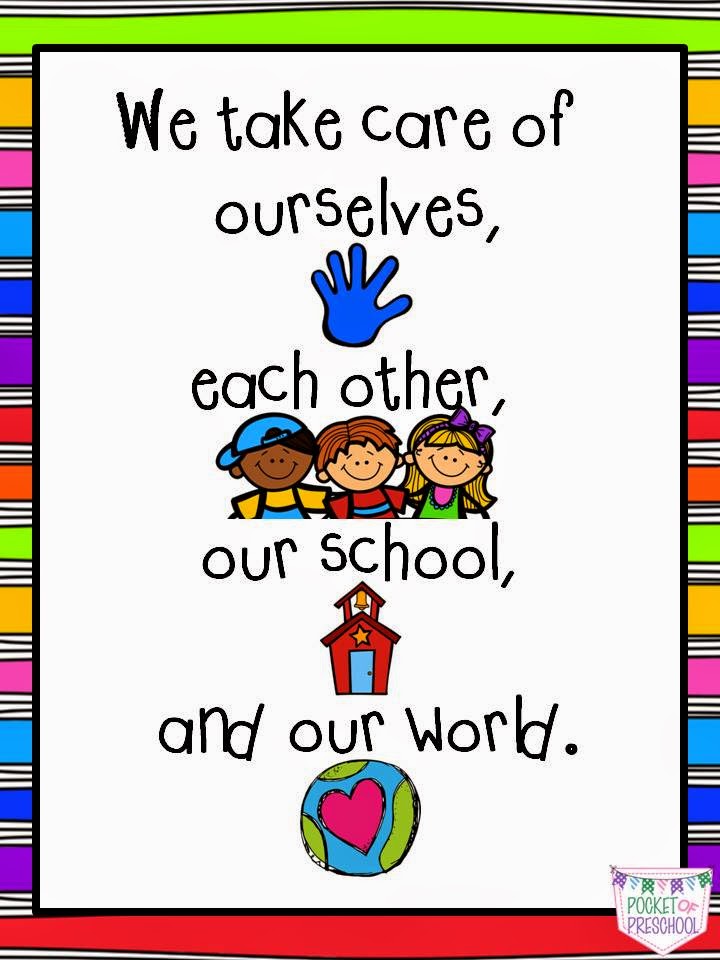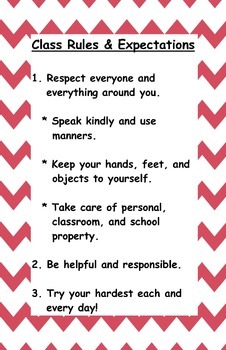In my opinion, the most important part of class rules is that they are valued and lived by the teacher, truthfully, in his or her own life. These rules should be meaningful and reinforced often, not just hung up on the wall and left to collect dust. They should be created in the classroom with the kids, not forced upon them. The kids should sign the rules document posted in the classroom. Decide Upon Classroom Rules and Expectations Teachers often involve their students in the creation of the classroom rules and expectations during the first few days of the school. There is usually a process of collecting and combining all of the students’ ideas until the class revises and agrees to a list of classroom rules and expectations. Classroom rules are necessary for learning to occur. When students misbehave, they are disrespecting their peers. Everyone in the class has the right to learn. If a student interrupts other students who are trying to learn, that needs to be stopped. Covid-19 Class Rules. 5 3 customer reviews. Author: Created by areeverett. Created: Aug 29, 2020. Ruling for the classroom in regards to Covid-19.
With teachers at all levels of education around the country continuing to teach many, if not all, of their classes in a virtual environment, they’re quickly adapting to this new online learning environment and the benefits and challenges it brings. One important best practice that many are adopting relates to virtual classroom rules and expectations.
While, in many ways, virtual classroom rules and expectations are not much different than expectations instructors have of students in the physical classroom, it’s important to be explicit about the rules to ensure student compliance and to set the stage for a positive learning environment. Here we take a look at some common virtual classroom rules and expectations being established at both the K-12 and higher-ed levels.
At the K-12 level, both students and their parents should be involved when communicating expectations of online learning and virtual classrooms, ranging from suggestions for the best environment for learning to rules of engagement.
Sarah Miller, ateacher and blogger, says: “One important rule for kids to remember when they are attending online classes is to treat their home like a public space,” says Miller. “Everyone in the class can see what’s on their camera.” Students, she says, should dress as they would if they were coming to school physically. “They should try to find a place that has minimal distractions in the background and minimal background noise,” she says. Importantly, they need to understand that the class can see everything that their camera can see.
Since technology is such an integral part of the online learning experience, teachers also need to ensure that students (and parents) are comfortable with the technology.

Taking classes online has been new for many students, especially those at the K-12 level. It’s important, says Miller, for students to know how to use the technology that is being used and to follow whatever norms might be in place with the technology.
For instance, she says: “I like to mute all the kids’ microphones during the lesson, and only unmute one child at a time when they are answering or asking a question.” This, she says, helps students understand how to mute and unmute their own microphones. They should also learn how to type a question or answer in the chat box, she says. “ It helps for kids to understand how to mute and unmute their microphone and type a question or answer in the chat box, so that they can participate fully in the lessons. “If kids are too young to do these things on their own, parents should be nearby and paying attention to the lesson so that they can help out,” Miller suggests.
Classroom Rules And Expectations Template
And, while common rules of courtesy may seem obvious, teachers should be explicit about their expectations for engagement in virtual classrooms.

It’s important to establish clear expectations for virtual classrooms, says Margaret Choi, who is an SEO manager and teacher atCodeWizardsHQ, where she teaches all of her classes virtually to students age 8-18. These will vary based on student age, she says.
“Every class is different, but general ground rules of being respectful of me and each other and not talking over each other. I ask students to put their listening ears on and focus in.” With younger students, she says, mics are kept on mute, and “we stay locked in our seats.” Students are asked to use the raise hands feature in Zoom if they have questions.
With older students, mics and cameras are left on to encourage participation. But, she says, there’s “no playing around with annotations or drawing on the screen; some kids provide helpful annotations and that is welcome.” What’s nice, she says, is “I can easily stop any speaking out of turn or messing with the presentation with a simple click.”
In addition, she says, she asks students to use their real names. Anticipating and preparing for the kinds of issues that can lead to disruption, up front, can make it easier to manage unexpected situations that occur when teaching in virtual classrooms.
Things can go wrong in a virtual environment and Choi recommends preparing students for the unexpected up front. “I give them a warning up front on what to do if I ever disappear,” she says. “First don’t panic! I will be back, promise. I’m not actually gone, or I will send someone in to help.”
Higher-Ed Virtual Classroom Rules and Expectations
There are some virtual classroom rules and expectations that transcend age and grade or level in school. Managing surroundings, knowing how to use the technology, and basic rules of engagement, for instance.
At the higher-ed level, and even in more advanced grades in K-12, instructors should involve students in creating ground rules for the virtual classroom. This involvement will help them feel more ownership and responsibility for adhering to the guidelines and may also lead to expectations that the instructor hadn’t thought of. Some areas of potential discussion to help create explicit expectations for virtual classrooms and online learning might include:

- Keeping cameras on unless the student has received explicit permission to not do so; the ability to use backgrounds, and to blur out backgrounds can help in situations where students may have concerns about privacy or other issues.
- Students should be attentive and prepared to respond to a question at any time during the class period.
- When to use the chat feature, versus asking a question out loud; what types of questions should be raised via chat versus out loud?
- How should annotation, emoticons and stickers be used, if at all, when the professor or others are presenting?
- Expectations for interacting in breakout rooms; instructors should clearly indicate that they will be “popping in” to these rooms randomly to check on student progress and respond to any questions, for instance.
- What is, or what may not be, appropriate to share when screen sharing.
Students aren’t the only ones who should be expected to follow certain guidelines and meet expectations for engaging during online classes—instructors should also commit to following the same expectations, and any others that students may recommend.
While every situation and virtual classroom is different, and needs will vary based on age, grade level, and course content or type of course, what’s most important is making expectations clear and explicit at the outset, while also leaving the door open for additional virtual classroom rules and expectations to be raised throughout the course.
Classroom Rules And Expectations Powerpoint
It’s a shared learning experience for all of us. Flexibility and a commitment from all to contribute to a positive learning environment will help to make virtual learning as positive and engaging as possible.
